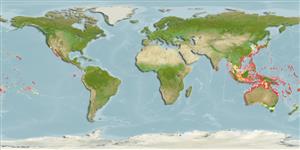>
Eupercaria/misc (Various families in series Eupercaria) >
Labridae (Wrasses) > Corinae
Etymology: Coris: Greek, kore, -es = pupil and also with themenaing of "maid" (Ref. 45335).
More on author: Fowler.
Environment: milieu / climate zone / depth range / distribution range
Ökologie
seewasser riff-verbunden; tiefenbereich 2 - 40 m (Ref. 37816). Tropical
Western Pacific: Sagami Bay, Honshu south to Victoria, Australia and New Caledonia and east to Tonga.
Size / Gewicht / Alter
Maturity: Lm ? range ? - ? cm
Max length : 38.0 cm TL Männchen/unbestimmt; (Ref. 90102)
Rückenflossenstacheln (insgesamt): 9; Rückenflossenweichstrahlen (insgesamt): 12; Afterflossenstacheln 3; Afterflossenweichstrahlen: 12. Body greenish with pink longitudinal lines and white barring (Ref. 48636). Body greenish with several red stripes breaking into spots posteriorly and about 8 thin vertical pale bars. A black spot rimmed with yellow on posterior margin of opercle. A black spot at posterior basal portion of dorsal fin. First 2 dorsal-fin spines with flexible tips slightly longer than other dorsal-fin spines (Ref 9823).
Found in coastal to outer reef habitats in deep gutters or along reef margins (Ref. 48636). Inhabits rocky and coral reefs, in areas with rubble, weed and sand (Ref. 9710). Found solitary (Ref. 90102).
Life cycle and mating behavior
Geschlechtsreife | Fortpflanzung | Ablaichen | Eier | Fecundity | Larven
Oviparous, with distinct pairing during breeding (Ref. 205).
Randall, J.E., 1999. Revision of the Indo-Pacific labrid fishes of the genus Coris, with descriptions of five new species. Indo-Pac. Fish. (29):74 p. (Ref. 33411)
IUCN Rote Liste Status (Ref. 130435)
Bedrohung für Menschen
Harmless
Nutzung durch Menschen
Aquarium: Kommerziell
Mehr Information
ReferenzenAquakulturAquakultur ProfilZuchtlinienGenetikElectrophoresesVererbbarkeitKrankheitenVerarbeitungNutrientsMass conversion
PartnerBilderStamps, Coins Misc.LauteCiguateraGeschwindigkeitSchwimmstilKiemenoberflächeOtolithsGehirngrößeSehfähigkeit
Tools
Zusatzinformationen
Download XML
Internet Quellen
Estimates based on models
Preferred temperature (Ref.
123201): 22.4 - 28.9, mean 27.5 °C (based on 532 cells).
Phylogenetic diversity index (Ref.
82804): PD
50 = 0.5000 [Uniqueness, from 0.5 = low to 2.0 = high].
Bayesian length-weight: a=0.00977 (0.00470 - 0.02030), b=3.07 (2.89 - 3.25), in cm total length, based on LWR estimates for this (Sub)family-body shape (Ref.
93245).
Trophic level (Ref.
69278): 3.5 ±0.3 se; based on size and trophs of closest relatives
Widerstandsfähigkeit (Ref.
120179): mittel, Verdopplung der Population dauert 1,4 - 4,4 Jahre. (Preliminary K or Fecundity.).
Fishing Vulnerability (Ref.
59153): Low to moderate vulnerability (28 of 100).
Nutrients (Ref.
124155): Calcium = 37.2 [14.6, 100.6] mg/100g; Iron = 0.558 [0.333, 0.989] mg/100g; Protein = 18.6 [15.7, 20.8] %; Omega3 = 0.127 [0.064, 0.249] g/100g; Selenium = 32 [12, 89] μg/100g; VitaminA = 102 [33, 353] μg/100g; Zinc = 1.87 [0.88, 3.36] mg/100g (wet weight);
